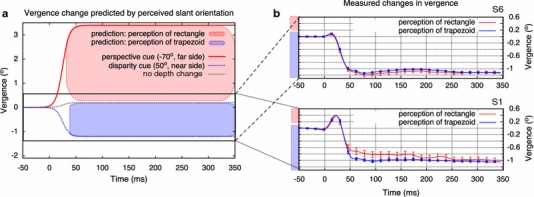Fig. 4.

a Predicted vergence changes based on perceived surface slant orientation. The transitions between vergence at saccade onset (t = 0 ms) and at saccade offset are described using a sigmoid function. The upper and lower limits of the predicted vergence regions are based on the vergence step corresponding with the depth defined by a single cue. The box indicates the range of the detailed graphs in b. b Vergence changes based on perceived surface slant orientation of subject S6 (top) and subject S1 (bottom). Mean traces for each condition with SE of every fourth data point are displayed. Saccade offset occurred at 55 ms for S6 and at 46 ms for S1 conform main sequence characteristics (saccade onset at t = 0 ms). These data show that (1) saccade offset does not coincide with offset of preprogrammed vergence per se, (2) that the “perception of rectangle” condition is more converging than the “perception of trapezoid” condition from S6, which is opposite to the traces of S1
